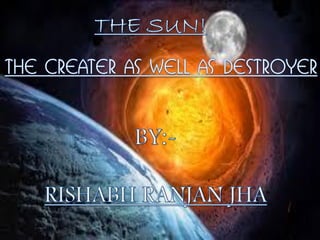
the sun!
- 2. WHAT IS SUN ACTUALLY ? We live in a unique system called solar system. It includes the sun , eight planets and other celestial bodies. The sun is the main member of this solar family. Now the question arises that-what is sun actually? So the answer is that sun is a star at the center of our solar system. The diameter of sun is 109 times of earth that is 1.39 million kilometers . Its mass is about 330,000 times that of the earth the surface temperature of sun is about 5800 K and the temperature of its core is about 15,600,000 K. It holds about 98.8% of total mass of whole solar system. It is not a matter of joke that about one million earths could fit inside the sun. One would need to explode 100 million tons of dynamite to match the energy which is produced by our huge sun.
- 3. HOW SUNWAS BORN ? It is the story of the birth of the sun, the story starts before 4.6 billions of years ago According to the scientist a large cloud of dust and gases called nebula in the space was disturbed , due to explosion of star supernova or some other reason. Due to the explosion waves were made in the space and these waves squeezed the cloud of dust and gases. Squeezing made the cloud start to collapse, as the Gravity pulled the gas and cloud together forming The solar nebula. It span like a dancer spins his or her arms and finally the cloud was collapsed. Now, it became hotter and denser at the center, which was surrounded by many gases and dust. It was hotter at the center but cooler at the edges. So this hot and dense center took the role of sun and the edges became planets.
- 4. WHAT ARE SUN SPOTS ? Sunspots are magnetic in nature. They are the places where the Sun's magnetic field rises up from below the Sun's surface and those magnetic regions poke through .they are the active. They are darker than the surrounding areas because they expend less energy and have a lower temperature. They are caused by the Sun's magnetic field welling up to the photosphere, Which is the Sun's visible surface. The powerful magnetic fields around sunspots produce active regions on the Sun, which often lead to solar flares and Coronal Mass Ejections Our Sun isn't the only star with spots. These spots of the sun can be visible through a normal telescope with a solar filter. They can also be seen in the above pictures in this slide.
- 5. SOLAR STORMS ! Now we have understood the meaning of the sun spots and the formation of the sunspots. So it is not much difficult to under stand the meaning of solar storms. We know that the sun spots are the active region so, due to the magnetic fields these spots eject the coronal mass from sun’s core. These ejections some times are very massive so that the can reach earth also which are called the solar flares or storms. Planet mercury in every ejection remains the victim of the solar storms. These storms if more massive then can create a lot of destruction in our planet. Due to these solar storms the surface temperature of the earth increase that much that it is not possible to move out of our houses. Some times these storms cause destruction to the magnetic field also. It is said that planet mars was having life on it but due to solar storm the magnetic field got disappeared and the life ended.
- 6. IS LIFE POSSIBLE WITHOUT SUN ? The sun has a great use not only in the magnetic field or vitamin D but more than this, let us take an example that if sun is not there for a month. We all know that human beings and the plants are dependent on each other at night time the plants inhale the oxy gen and exhales the carbon dioxide, if there will be no sun then it will be night only. Then we the human beings can’t inhale carbon dioxide for a month so we will die. After sometime the water on the earth will star freezing then the plants will also die. Due to this the marine animals will die. Some species of polar animals will sustain for sometime but not for very long time. So the sun is alive so we are alive but on the other hand it is a destroyer also.